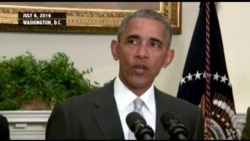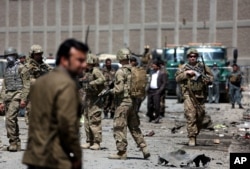U.S. President Barack Obama’s plan to maintain 8,400 U.S. troops in Afghanistan through the end of his presidency leaves many unanswered questions about the best path forward as the security situation continues to worsen, experts said.
The administration had initially planned to reduce the number of U.S. troops from the current 9,800 to around 5,500 by the end of 2016. But Obama said Wednesday that the security situation in Afghanistan "remains precarious" and so he is leaving more troops than originally planned through the end of his administration.
"The Taliban remains a threat. They’ve gained ground in some cases, they’ve continued attacks and suicide bombings including in Kabul," Obama said. "Because the Taliban deliberately target civilians more Afghan men, women and children are dying and often overlooked in the global refugee crisis."
WATCH: Obama statement on Afghanistan
U.S. troops in Afghanistan have been working on two missions. Those missions include advising and assisting Afghan troops as they battle the Taliban and combating al-Qaida-linked extremists and efforts by Islamic State to establish a foothold in the country.
“Even as they improve, Afghanistan security forces are still not as strong as they need to be,” said the president.
Obama said he made the decision to leave more troops in Afghanistan after reviewing the recommendations by his new U.S. commander in Afghanistan, Army General John Nicholson, and on the advice of Defense Secretary Ash Carter and other military and intelligence officials.
Dire conditions
No matter how much progress U.S. officials insist has been, overall conditions in Afghanistan remain dire, said Anthony Cordesman, military analyst and Arleigh A. Burke Chair in Strategy at the Center for Strategic and International Studies.
“You haven't seen major military defeats, but you seen a rise in casualties. You’ve seen some serious problems for the Afghan forces. The Afghan Air Force is having problems in growing. The Afghan police the ALP, is not doing well,” said Cordesman.
He added despite efforts to reform a notoriously corrupt government, lift up Afghanistan’s economy and implement costly programs to build up its infrastructure, little progress has been made.
“You are watching the economy reach a crisis point. The World Bank and other sources note that this is a serious problem in terms of stability. You see no improvement in terms of practical reform,” he added.
Meeting with Afghan officials
The president said that during the NATO summit in Warsaw, Poland later this week, he will meet with Afghan President Ashraf Ghani and Chief Executive Abdullah Abdullah. He will also press coalition partners to commit troops and funding to help strengthen Afghanistan through the end of this decade.
“I’m confident they will, because all of us have a vital interest in the security and stability of Afghanistan,” said Obama.
But with only a few months left in office, Obama will likely have a difficult time securing long-term commitments.
“For all of the NATO countries that are in Afghanistan, the key issue often isn't as much U.S. strategy as it is, ‘Is the U.S. staying?” suggested Cordesman. “How committed is the U.S.?”
Next US administration
Obama said leaving more troops in Afghanistan when he leaves office will give the next U.S. president “a solid foundation for continued progress in Afghanistan as well as the flexibility to address the threat of terrorism as it evolves.”
The troop level decision, he added, sends a message to the Taliban that the U.S. and the international community's "commitment to Afghanistan will endure.”











